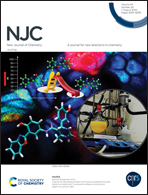A simple, cost-effective and selective analysis of glucose via electrochemical impedance sensing based on copper and nitrogen co-doped carbon quantum dots†
Abstract
Copper and nitrogen co-doped carbon quantum dots (Cu,N-CQDs) were prepared by a facile hydrothermal treatment, and they were further employed as a novel sensing material for fabricating a sensitive non-enzymatic glucose sensor. The morphologies and structures of the as-prepared materials were characterized by using UV-vis spectrophotometry, fluorescence (FL) spectrophotometry, Fourier transform infrared (FT-IR) spectrophotometry, transmission electron microscopy (TEM), X-ray photoelectron spectroscopy (XPS), cyclic voltammetry (CV) and electrochemical impedance spectroscopy (EIS). It is interesting to note that the introduction of Cu into the as-prepared Cu,N-CQDs caused a ca. 4-fold increase over that of N-CQDs in the electrocatalytic oxidation peak current of glucose. The proposed sensor showed excellent sensitivity and selectivity for glucose detection in alkaline medium with a linear range of 5–700 μM, and the detection limit was calculated to be 1.22 μM (S/N = 3). Furthermore, the as-prepared sensor was utilized to detect glucose in a fermentation sample, suggesting the Cu and N co-doped CQDs as a promising candidate for fabricating sensors for the quantification of glucose.



 Please wait while we load your content...
Please wait while we load your content...